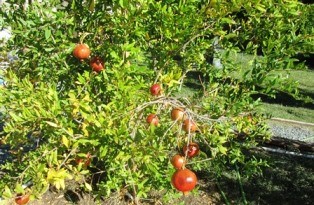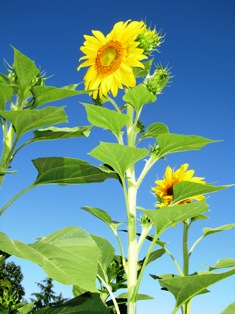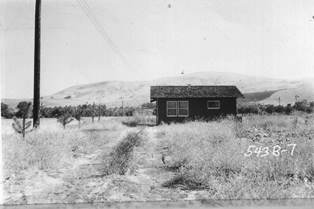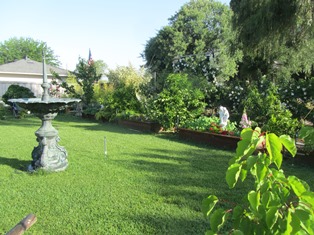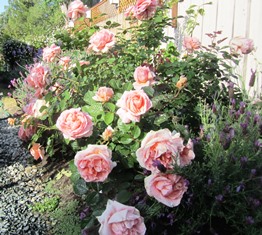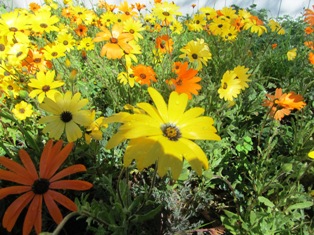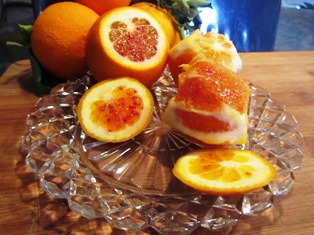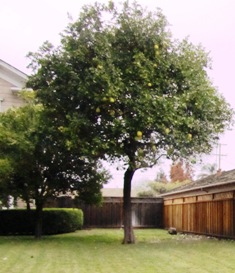Blog Archives
To-Do List of Chores for the Fall Garden
From my office widow, I look out over what once was a lush and thriving garden. Not so today.
I can hardly bear to gaze upon the sorrowful, dried tomato vines that for me have come to symbolize the severity of the extreme drought on California gardens.
Now that fall will soon arrive, I’ll toss onto the compost pile those vines along with others from pumpkins and hard-shelled squash.
So with the garden cleared, I’m thinking ahead to next year, ever hopeful we’ll get rain rather than a repeat of dry conditions like this past year.
To ensure the viability of our fruit trees, citrus trees, and various berries through the fall and winter, there is a spray regimen to be initiated. I’ll add it to my long list of chores that will need to be done.
MY FALL CHECKLIST FOR THE GARDEN
Turn the soil, add amendments like compost to hold in the water.
Prepare new beds.
Build cold frames and 4- x 6- foot boxes for new raised beds.
Cut the canes of blackberries (berries only set up on two-year-old canes that won’t again produce; cut to ensure new fruiting canes will take their place).
Prune away the spent floricanes of red raspberries, once they’ve produced fruit.
Clean up around the bases of all trees and evergreen plants; add mulch.
Also remove all leaves at the base of all fruit trees and dispose.
Remove rose leaves after blooming season, cut canes to 18 inches, and spray for diseases and pests.
Stake young trees so they’ll survive windy winters, growing straight and tall.
Treat the trees with an organic spray (one containing copper and protector oil) to prevent fungal disease and pests.
Get out the frost cloth in readiness to cover tender citrus trees.
Prune back the hydrangeas.
Plant fall bulbs for spring flowering.
Crafts You Can Make from Your Backyard Garden
Invariably, when fall and winter holidays roll around each year, I find myself wishing that I’d planned ahead and utilized more raw materials from the garden for gift-giving. If you have had a similar experience, here are some ideas for turning what you grow into heart-warming gifts.
At summer’s end, harvest the seeds of your favorite flowers like cosmos, sunflowers, nasturtiums, zinnias, and even vegetables. Dry and re-package into paper envelopes that you hand-stamp, emboss, or otherwise embellish for gift-giving. Be sure to include information about how to grow the plant.
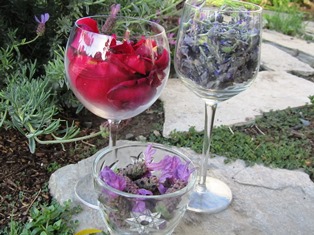
Rose petals, Spanish lavender, and French perfume lavender can be used to make a flower essences or potpourri
Flowers and herbs, picked at their zenith, can be turned into potpourri, fragrant soaps, soothing lotions, and skin moisturizers.
If you keep bees in your backyard garden, consider using the extra wax for dipping candles. Of course, honey is highly prized for its healthful properties, so be sure to jar up plenty of honey for gift-giving occasions.
Vines, berries, and pine cones are easily transformed into wreaths and dry arrangements.
A bottle of vodka, gin, or other spirits can be transformed into a gourmet gift by the addition of sun-ripened berries, herbs, vegetables (such a cucumber), or fruits and then stored in a dark, cool place for at least six weeks.
Gourds make lovely bird feeders and bird houses.
Just imagine the delight a dried-pepper wreath, a garlic braid, or jars of dried beans and seeds might evoke.
Make sheets of homemade paper, incorporating colorful rose petals, lavender, or pansies. Making paper is easy if you have a blender, some scraps of paper (junk mail works), and water.
Seed cakes, created from crunchy peanut butter, seeds, nuts, and dried fruit, make great gifts for bird lovers who can place them near feeders during the cold months when the bird must vigorously forage for food.
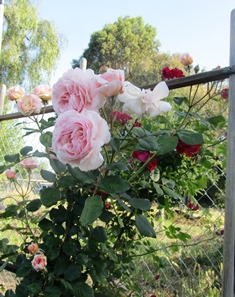
Re-potted cuttings of your garden favorites make lovely gifts for other gardeners in your family or circle of friends
Take cuttings in fall or early spring from your roses, dip the cuttings into root hormone, and plant the cuttings into a pot of soil that you keep damp until the roots have formed. Or dig bulbs (bearded irises, for example) and place in a tin for gift-giving.
Preserve jars of pie-filling, do up crocks of pickles, or create mouth-watering chutneys and special relishes. Wrap the jar lids in gingham and ribbon. Use hot-water canning of fruit and citrus into jam, jelly, and marmalade. Place jars of these items into a food basket, made festive with the addition of colorful tea towels or tissue paper and ribbon.
Use clean, dry corn husks for tamale-making, or craft them into corn husk dolls.
With a little forethought and advance planning, you’ll have plenty of backyard bounty to harvest and turn into gifts for almost any holiday or special occasion.
The Farmette Renovation Work Continues through All Seasons
I met with the tax assessor last month and he gave me a picture of our small farmette house from 1953. At that time, the house was only six months old. Over the ensuing years, many changes were made, rendering the tiny miner’s shack or bunkhouse (that appears to have been a single room) into a 2-bedroom, 2 bath house of roughly 1,000 square feet. We continue to renovate but limited resources slows everything. Eventually, we’ll have a small finished house in a lovely environment.
When we found the property in 2009, it was in foreclosure and looked like a dump. That’s because it had been used as one. Broken pieces of granite and cabinetry wood had been piled along its aging, rotting fences, too weak and weary to remain upright. Inside, the hardwood floors had been ripped off and everything that could be “harvested” from the house by others had been taken. The only appliance was an old refrigerator sitting a weed-field that served as the back yard.
But we saw land all around. Rising up to the north in back of our farmette are hills (emerald green in the rainy season) that separate the inland valley where our farmette is located from the great Central Valley of California. Seeming as near as our front yard, the blue-green peaks of Mount Diablo tower over the landscape in the east and southeast (we now see these from our living room couch and front porch). From the northwest in summer, the breezes off the San Francisco Bay where it becomes the Straits of Carquinez blow toward Mount Diablo around 4:00 P.M. every day to cool the area.
After pulling out the weeds that at one point towered over our heads, we envisioned re-engineering everything. We constructed a new landscape that included fruit, citrus, and nut trees, beds for roses and other flowers, an heirloom herb and vegetable garden, and a designated area for bees and chickens.
Without a huge budget, we believed the renovation of the house would be ongoing (and it has been). This is our fourth winter. When we are not working outside, we are working on the renovation inside. For example, recently we installed window trim in the living room. Today, I’ll caulk, spackle, and sand in preparation for painting later this week.
Previously the entry into the house was through a side door and bathroom. The first impression wasn’t good. My husband created a welcoming entrance with exterior moldings around the windows and door. I talked him into a screen door and a porch (as yet unfinished) with a trellis to support purple wisteria.
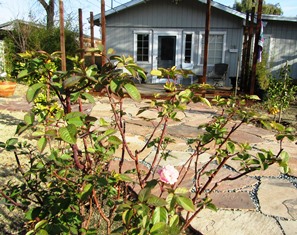
A flagstone path lined with roses and citrus trees leads to the new front door but the porch is yet to be finished
Since unseasonably warm temperatures have been forecast for the week, we have begun work on a flagstone walkway leading to the porch. I love when Carlos gets out string, stakes, and the can of marking spray and begins putting down boundaries for fences, walkways, stone paths, and garden gates. The tax assessor didn’t ask about those markings. But we expect the property value to be listed higher next year because of the renovation we’ve already done.
February Color on the Farmette
It’s difficult to find color in the dead of winter. It’s the last week of February and around the farmette it’s beginning to look like spring. Mixed in with the drab brown and gray and green are dazzling splashes of orange and yellow.
On Sunday, my husband and I helped out a neighbor with the pruning of her fruit and citrus trees. My husband will also be removing her aged trellis, cutting back the Japanese wisteria and reducing the size of what looks to be a 20-year-old grape vine.
She had two orange trees both loaded with oranges, so there was harvesting to be done before we could even start pruning back the tree. One was a Valencia orange, known as the juice orange. I cut into several of them this morning and found them streaked with red. What came to mind was that perhaps the busy little honeybees had cross pollinated her Valencia with a Blood Orange. I’m growing several on the farmette.
Citrus trees need little pruning. It’s easy to thin the shoots and branches, rather than shortening the tree. You can also revitalize an old tree that is unproductive (my neighbor’s tree was old but still producing a lot of fruit) by pruning a little more severely but such a severe pruning can stop fruiting for one to two years.
Growers say to feed citrus four times a year; I feed mine once a month with a deep watering. Soils that don’t have good organic matter and nitrogen will benefit from compost, blood meal, cottonseed meal, and well rotted manure on the soil surface out to the drip line. If your citrus isn’t performing for you, try scratching around the surface of the soil under the tree. This stresses the surface roots. Citrus need good drainage. Water slowly and deeply.
We’ve been lucky to have a stretch of warm, sunny days here in Northern California at the end of February. The fruit and nut trees have burst into bloom. Around the farmette, there are pink and white buds opening on the apple, apricot, peach, and almond trees.
The field in the back is knee-high with wild mustard and its blooms are bright yellow on green stalks. The yellow and orange daffodils and purple hyacinths create a floral motif on the drab winter cloak of Mother Nature . . . at least here on the Henny Penny Farmette. Just another reason why I love living here.
Pruning Sixty-Year-Old Citrus Trees
When a friend who owns a house in San Jose asked for help in pruning her citrus trees (a lime, satsuma mandarin, and a grapefruit) during the first weekend in December, we agreed. The house had a lovely stone courtyard with two large citrus trees that had remained prolific producers in spite of being neglected for the last 20 years. The trees had been planted, she told us, approximately 60 years ago by an aunt.
Standard size citrus trees can reach 20 to 30 feet and spread almost as wide. Dwarf citrus, however, only reaches four to ten feet. The latter can be grown as landscape specimens or in pots where they can be easily moved around to protect them from frost and wind. In really hot, dry conditions, citrus in pots may need daily watering.
Once in San Jose, we checked the trees for diseases and pests. Aside from some of the lime leaves that had turned yellow, suggestive of too either much water or iron chlorosis (simply corrected with a little iron sulfate or chelated iron), the trees otherwise looked pest-free and loaded with ripe fruit.
Wearing gloves and long sleeves to protect against thorns, we shook the trees vigorously to remove unpicked fruit of previous seasons and the current season’s ripe fruit. The shaking yielded a five-gallon bucket and two partially full contractor bags of delectable limes and satsuma mandarins. The owner was delighted to have so much fruit. She even offered us some to make into marmalade, but we explained we had plenty of our own citrus on the farmette.
We carefully pruned out all the old dead branches and began shaping the trees, lifting and cutting branches that pointed down, removing crossed-over limbs, and cutting away branches that compromised the courtyard fence. Our work reduced the height and width of the trees (making it easier to harvest any fruit still hanging).
The work went smoothly. We even had time to tackle the ragged-looking grapefruit tree in the back. By the end of the day, we had freed three beautiful trees from a tangle of dead limbs and picked many pounds of fruit. The trees were once again serving the purpose for which they were planted–heavy producers that enhanced the beauty of the landscape.
 Facebook
Facebook Goodreads
Goodreads LinkedIn
LinkedIn Meera Lester
Meera Lester Twitter
Twitter






